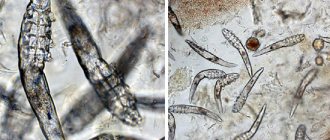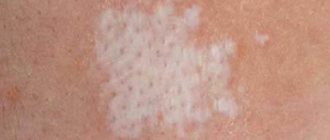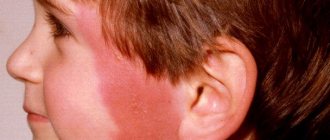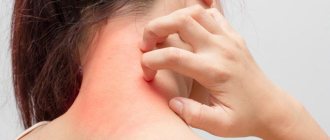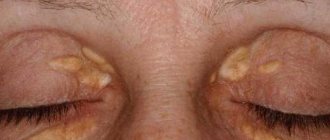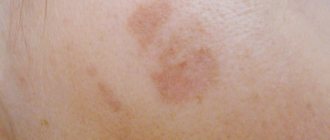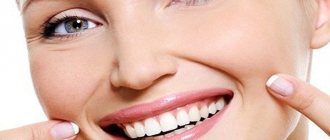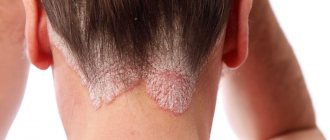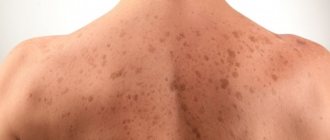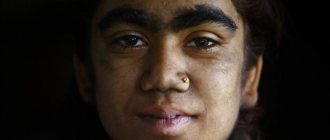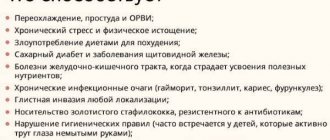Most ticks have a very recognizable appearance: a flat creature with a rounded body and 4 pairs of legs. The sizes of arthropods can be very different: from easily visible to the eye to microscopic. But the subclass of mites also includes creatures that can hardly be recognized as arachnids. It is a facial mite that causes skin disease in humans.
Facial mite or Demodex: what is it?
Face mites or Demodex mites are obligate ectoparasites (parasites living outside the host's skin that cannot complete their life cycle without the host) found on human skin. Infection with demodicosis is widespread in humans.
In any healthy adult, Demodex infection ranges from 23 to 100%. These mites remain on your skin without showing any symptoms. However, an imbalance in the number of facial mites can cause certain skin problems.
There are about 65 species of Demodex, but only two of them are found on human skin. This:
- Demodex folliculorum (D. folliculorum): These are found in hair follicles and on the side. They feed on dead skin cells and sebum. Excess D. folliculorum on your skin can enlarge the epithelial cells in your hair follicles, making your skin feel rough and scaly.
- Demodex brevis (D. brevis): Unlike D. folliculorum, D. brevis is not limited to just the face. These mites are more common on the neck and chest and have a wider distribution on your body. They penetrate deeper into your sebaceous glands and ducts and feed on the cells of your glands.
These mites were first identified in 1841-1842. D. folliculorum infestations are more common in humans. These infestations increase with age.
We recommend reading
How to get rid of blackheads at home
The incidence of facial mites is highest in people aged 20 to 30 years. This can be attributed to increased sebum secretion. Compared to women (13%), the incidence of facial mites is significantly higher in men (23%).
Face mites can be transmitted between hosts through physical contact (nose, hair, eyebrows, etc.). They are mostly harmless and do not cause any symptoms. However, certain external and/or internal factors (such as inherited defects in T cells and the immune system) can cause colonization of facial mites, leading to certain skin diseases.
Medication
There are a very large number of drugs that are used for demodicosis. They are divided into antiparasitic, antimicrobial, anti-inflammatory, antibacterial and others. Each of the presented remedies has its own characteristics and healing properties.
Let's take a closer look:
- Antiparasitic. Quite effective and capable of destroying subcutaneous mites in a short time. But they have a significant drawback: parasites can get used to the effects of the active substances of the drug, which will make it ineffective. Most often they are prescribed in combination and help relieve symptoms. Such drugs include Trichopolum, Spregal, Ornidozole and others.
- Anti-inflammatory, antimicrobial. Their action is aimed at reducing the parasite population. They also help restore the metabolic processes of the skin. These include Ichthyol ointment, Azelaic acid, Benzyl benzoate emulsion, Tar.
- Antibacterial. They are prescribed in ophthalmology to relieve symptoms and get rid of the disease. These include Colbiocin, Demalan, Eubetal antibiotic.
- Antihistamines. Products that help relieve swelling of the skin and get rid of itching.
- Vascular strengthening. Helps strengthen blood vessels and prevent damage from parasites.
- Immunostimulating. Strengthen the immune system.
- Medical cosmetics. Special products that are designed for disease treatment and prevention. These include Demodex Complex.
Physiotherapy, ozone therapy, TCA peeling, cryotherapy are also effective, which contribute to rapid recovery and restoration of processes.
Sulfuric ointment
This ointment has a detrimental effect on ticks from the first day of use. It also helps relieve inflammatory processes. The main active substance is sulfur, which has an antiparasitic effect. Most often it is the main means of therapy.
Before using the ointment, it is necessary to cleanse the skin well as this increases the effectiveness. You need to apply a thin layer, it does not wipe off and is washed off, you need to wait until it dries completely. The procedure is performed 2 times a day. Course 1 month. When using sulfur ointment, other means for local treatment are not used. Possible side effects in the form of an allergic reaction.
Permethrin ointment
The main active substances are pyrethroids, which have a detrimental effect on the parasite. The mechanism of action is as follows: the drug applied to the skin is quickly absorbed, the active substances act on the tick by contact. So, the active substance penetrates the parasite’s body and affects the nervous system, paralysis occurs, and then death.
The drug is absolutely safe for humans; it is quickly eliminated from the body. It is necessary to apply a thin layer of the product and give it several hours to absorb, after which you can wash off the residue with water. Used 2 times a day. If you feel a burning sensation during application, you should wash it off and do not use the ointment. You should consult your doctor again.
Benzyl benzoate
Most often prescribed in the presence of demodicosis and infection with secondary infections. It acts directly on the parasite, which leads to its death within an hour. In addition, the ointment prevents the proliferation of pathogenic microorganisms and bacteria that cause infectious diseases.
For local use, it can be used in combination with other local products. Apply the drug in a thin layer to clean skin. Can be used 1 or 2 times a day.
The drug is not prescribed to pregnant women.
Side effects are possible, which manifest themselves in the form of rash, itching, burning. In such cases, the use of the drug is prohibited and the doctor prescribes another remedy.
Yam ointment
A fairly universal remedy that is prescribed for the treatment of demodicosis and other diseases. The composition contains several active substances that help get rid of subcutaneous mites. Apply a thin layer until completely absorbed, 2 times a day. Regarding the course of treatment, it lasts 2 weeks, after which it is necessary to pass the appropriate tests. If the disease is still present, the drug may be prescribed for a second course of treatment.
Zinc
A very effective and universal remedy that allows you to quickly destroy the subcutaneous parasite. The drug contains two active components, zinc and petroleum jelly, which together have many beneficial properties. In addition to killing the parasite, it helps reduce inflammation. It dries out the infected areas, which creates unfavorable conditions for the mite. Helps restore regeneration processes. It is used for burns, ulcers, eczema.
The course of treatment is 7 days, applied in a thin layer. It needs to be used 5 times a day. Regarding side effects, no such effects are observed; isolated cases are possible when a person does not tolerate any of the components of the drug. Prescribed to pregnant women and during breastfeeding.
When using any of the above ointments, it is very important to adhere to the instructions for use and follow the doctor's recommendations. During treatment, it is prohibited to use cosmetics and cosmetic care products, as this can reduce the effectiveness of the drug and worsen the condition of the skin. Remember that, for example, foundation clogs pores, which in turn causes greater production of subcutaneous sebum, and this is a favorable environment for mite reproduction.
Ichthyol
Refers to antiseptic drugs. It can be used as the main drug or as an additional one. Has analgesic properties. Apply a thin layer, the course of treatment is individual in each case and prescribed by a doctor. Not prescribed for children under 12 years of age. Side effects such as rash and hives are possible; in such cases, the ointment is not used.
Facial mite: causes, symptoms and complications
You can't get rid of facial mites. They are always present on your skin. However, if their number increases, they can cause several complications. Here are the symptoms of both types of facial mites.
D. folliculorum
If your skin is infected with D. folliculorum, it will become rough and scaly. D. folliculorum increases the number of epithelial cells in your hair follicles. Other symptoms of this infestation include:
- Skin redness
- Itchy skin
- Burning
- Eczema
- Rough texture
- Skin sensitivity
These symptoms are common. Several factors may increase the risk of becoming infected with D. folliculorum:
- Alopecia
- Weak immune system
- Dermatitis
- Skin infection
- Rosacea (loss of eyelashes)
Researchers are still investigating the connection between D. folliculorum infection and several other skin conditions. Some studies may establish a possible link between D. folliculorum and rosacea. Skin conditions may be a risk factor for Demodex infection in the eyelashes.
D. brevis
If your skin is infected with D. brevis, it may appear red with rough patches. The most common symptoms of D. brevis infection are:
- Burning sensation on the skin
- Redness
- Roughness
- Itching
- Rash
- Changes in skin color
- Roughness
Several factors can increase your risk of developing D. brevis infestation. This:
- Acne
- Oily skin
- Eczema
- Acne
- Weak immune system
- Hair loss
Detecting facial mites or demodex is not entirely easy. Most of us are unaware of these parasites until they cause symptoms.
We recommend reading
Why do capillaries burst on the face and how to treat it?
How to fight subcutaneous mites with folk remedies?
- yellow clay, which has bactericidal properties, is applied to the affected areas of the skin for 10 hours. The clay must first be kneaded to form a soft paste;
- aluminum alum, white clay, crushed streptocide. After mixing these components in equal parts, dilute them with water until a soft mass is obtained. It is recommended to apply this mask at night;
- Wash your face regularly with tar soap. It is also recommended to periodically wash your hair with tar shampoo;
- Grind the laundry soap, fill it with water and shake until foam forms. This foam is applied to the affected areas of the skin. There is no need to wash off the foam; wait until it dries on its own.
Disease prevention
To reduce the likelihood of active development of subcutaneous mites, it is recommended to take preventive measures:
- follow a rest regime, because this will have a positive effect on the immune system;
- do not forget about the rules of personal hygiene;
- do not use other people’s personal items and other people’s cosmetics;
- follow proper nutrition, eat less spicy, fatty, sweet and smoked foods;
- protect skin from wind, rain, direct sunlight;
- quit bad habits;
- do not abuse baths and solariums;
- disinfect bedding and clothing;
- Don't forget to take care of your facial skin.
Facial mite (Demodex) diagnosis and treatment
A skin biopsy can help diagnose the presence of facial mites or demodex. Doctors perform a cyanoacrylic adhesion test along with a biopsy to find out the density of facial mites on the surface of your skin. They take a sample from your skin and examine it under a microscope.
This biopsy is necessary if you are experiencing serious complications caused by a severe facial mite infestation. Your doctor may suggest the following medications that may help minimize infection.
Treatments for facial mites
Keeping your skin clean is the first step to minimize facial mite infestations (as they feast on your sebum and dead cells). You may also be prescribed the following medications:
- Salicylic acid
- Ivermectin
- Benzyl benzoate
- Crotamiton
- Permethrin
- Selenium sulfide
- Sulfur
- Metronidazole
Your doctor may suggest topical or oral treatment, depending on the severity of your infestation. If the underlying condition is causing an infection (such as rosacea and eczema), you will need separate treatment.
If the infestation is mild, you can treat your face mites with simple home remedies.
Forecast
In most cases, the prognosis is favorable. Often, mites can be present without any clinical manifestations and go through their life cycle within a month. If there are concomitant diseases, purulent rashes or erythema appear, then treatment can last from a month to a year. Demodicosis does not go away on its own. Without treatment, the disease becomes chronic with damage to the deep layers of the dermis and the formation of abscesses. Therefore, it is better to consult a doctor, undergo examinations and a full course of treatment. If the diagnosis is confirmed, do not be upset. Daily regular skin care therapy will help cure the disease.
In conclusion, watch the video on how to treat demodicosis on the face.
Facial mites (Demodex) home remedies
Tea tree oil
The study tested several ingredients on Demodex. Tea tree oil has proven to be the most powerful facial mite killer due to the presence of terpinene-4-ol.
How to use
- Mix two to three drops of tea tree oil with any carrier oil and massage into your face.
- Leave it on for 30 minutes and then rinse with plain water.
- Repeat the exercise two to three times a week.
The same study found that dill weed and caraway oils also help kill facial mites. You can use these oils instead of tea tree oil.
Alcohol from Demodex
A study found that 100% alcohol can kill a facial mite in just 43.9 minutes. However, be careful when using 100% alcohol on your skin as it can cause skin irritation and contact dermatitis. Consult a physician before using alcohol on your skin.
We recommend reading
Simple Home Remedies to Remove Blackheads
Prevention of demodicosis
Prevention of demodicosis includes following simple but useful rules that will protect a person from the consequences of subcutaneous mite reproduction:
- Use less cosmetics or completely abandon such products.
- Strengthen your immune system to prevent re-infection.
- Change bed linen every two days.
- Razors, glasses, and objects that come into contact with the skin should be cleaned daily.
- You need to wash your skin twice a day (morning and evening).
- Use anti-demodectic agents.
Simple prevention will protect a person who has suffered from demodicosis and his entire family.
Connoisseur (342), closed 7 years ago
you should not overheat, smoked meats and spices are prohibited, any irritating food is prohibited, you should not drink cocoa and coffee, eat canned meat and fish, chocolate, alcohol is absolutely excluded, oil-based cosmetics are unacceptable. In other words, it is necessary to exclude everything that feeds or stimulates the reproduction of subcutaneous mites.
The diet should be selected so that the food is rich in vitamins A, B and C: liver, carrots, spinach, pumpkin, apricots, peaches, asparagus, broccoli, green peas, cabbage, seeds, buckwheat, coarse bread, sprouted cereals.
Exfoliating and antiparasitic procedures - cryotherapy with liquid nitrogen, potent ointments based on sulfur (5-10%), hydrochloric acid (6%), sodium thiosulfate, rubbing based on sulfur-tar alcohol, powder. Antihistamines - to exclude the possibility of allergies. Therapy that cures “risk factors” for alkaline-acid balance disorders includes strengthening the walls of blood vessels, vitamin therapy, absorbents, and in some cases a course of antibiotics. A gentle diet without fatty, fried, spicy, salty foods. General pest control! We boil bed linen and clean things! You cannot go to the bathhouse, sunbathe, or in the solarium, or use decorative cosmetics. And no cosmetic procedures - so as not to disrupt the treatment regimen.

